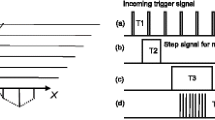Abstract
Absorption spectroscopy in the near infrared, visible and ultraviolet range can detect transitions between various electronic states of the material involved (intraatomic d-d and f-f transitions, intervalence charge transfer and ligand-to-metal charge transfer transitions). While d-d transitions are primarily sensitive to oxidation state, spin state and the geometry of the first coordination shell, intervalence charge transfer transitions can provide information on the spatial arrangement of higher coordination shells. In principle, electronic absorption spectroscopy is a powerful tool to investigate phase transitions involving structural changes or changes in the electronic state (oxidation state, spin state) of various materials. In practice, this method has rarely been applied due to the difficulties in obtaining absorption spectra at high temperature and at simultaneous high temperature and pressure. The major problems ecountered in high T absorption spectroscopy are due to the blackbody radiation of the sample. It is shown that this problem can be completely solved by combining Fourier-transform spectrometers with reflecting microscopes and microheating stages. The application of electronic absorption spectroscopy to the study of the glass transformation and to pressure-induced spin-pairing transitions is discussed in detail.
Similar content being viewed by others
References
Abu-Eid RM, Mao HK, Burns RG (1973) Polarized absorption spectra of gillespite at high pressure. Carnegie Inst Wash Yearbook 72:564–567
Burns RG (1993) Mineralogical applications of crystal field theory. 2nd edition, Cambridge University Press
Hazen RM, Burnham CW (1974) The crystal structure of Gillespite I and II: a structure determination at high pressure. Am Mineral 59:1166–1176
Figgis BN (1966) Introduction to ligand fields. John Wiley, New York
Gibbs JH, di Marzio EA (1958) Nature of the glass transition and the glassy state. J Chem Phys 28:373–383
Griffiths PR, de Haseth JA (1986) Fourier transform infrared spectroscopy. J Wiley, New York
Holmes OG, McClure DS (1957) Optical spectra of hydrated ions of the transition metals. J Chem Phys 26:1686–1694
Keppler H (1992) Crystal field spectra and geochemistry of transition metal ions in silicate melts and glasses. Am Mineral 77:62–75
Keppler H, Bagdassarov NS (1993) High-temperature FTIR spectra of H2O in rhyolite melt to 1300 °C. Am Mineral 78:1324–1327
Keppler H, McCammon CA (1996): Crystal field and charge transfer spectrum of (Mg,Fe)SiO3 majorite. Phys Chem Mineral, in press
Lin TC, Angell CA (1984) Electronic spectra and coordination of Ni2+ in potassium borate glass and melt to 1000 °C. Comm Am Ceram Soc 1984, 33–34
Martens RM, Rosenhauer M, Büttner H, von Gehlen K (1987) Heat capacity and kinetic parameters in the glass transformation interval of diopside, anorthite and albite glass. Chem Geol 62:49–70
Vlattson SM, Rossman GR (1987) Identifying characteristics of charge transfer transitions in minerals. Phys Chem Minerals 14:94–99
Meyers RA (1991) Encyclopedia of lasers and optical technology. Academic Press, San Diego
Ohnishi S (1978) A theory of the pressure-induced high-spin-lowspin transition of transition-metal oxides. Phys Earth Planet Interiors 17:130–139
Shankland TJ (1968) Pressure shift of absorption bands in MgO:Fe2+; the dynamic Jahn-Teller effect. J Phys Chem Solids 29:1907–1909
Shankland TJ, Duba AG, Woronow A (1974) Pressure shifts of optical absorption bands in iron-bearing garnet, spinel, olivine, pyroxene and periclase. J Geophys Res 79:3273–3282
Shen A, Keppler H (1995) Infrared spectroscopy of hydrous silicate melts to 1000 °C and 10 kbars: direct observation of water speciation in a diamond anvil cell. Am Mineral, in press
Sherman DM (1991) The high-pressure electronic structure of magnesiowustite (Mg,Fe)O: applications to the physics and chemistry of the lower mantle. J Geophys Res 96:14299–14312
Sowerby J, Ross N (1995) Electronic absorption spectra of clinoferrosilite to 5 Gpa. 2nd European Meeting on Resonance Absorption Spectroscopy in Mineralogy program with abstracts, Berlin
Stebbins JF, Sen S, Farnan I (1995) Silicate species exchange, viscosity, and crystallization in a low-silica melt: in-situ hightemperature MAS NMR spectroscopy. Am Mineral 80:861–864
Strens RGJ (1966) Pressure-induced spin-pairing in gillespite BaFe(II)Si4O10. Chem Commun 21:777–778
Strobel HA, Heineman WR (1989) Chemical instrumentation: a systematic approach. 3rd edition, J Wiley, New York
Tanabe Y, Sugano S (1954) On the absorption spectra of complex ions. J Phys Soc Jap 9:753–779
White WB, Moore RK (1972) Interpretation of the spin-allowed bands of Fe2+ in siliate garnets. Am Minerals 57:1692–1710
Zapunnyy SA, Sobolev AV, Bogdanov AA, Slutsky AB, Dmitriev LV, Kunin LL (1989) An apparatus for high-temperature optical research with controlled oxygen fugacity. Geochemistry International 26 2:120–128
Author information
Authors and Affiliations
Rights and permissions
About this article
Cite this article
Keppler, H. The investigation of phase transitions by electronic absorption spectroscopy. Phys Chem Minerals 23, 288–296 (1996). https://doi.org/10.1007/BF00207774
Revised:
Accepted:
Issue Date:
DOI: https://doi.org/10.1007/BF00207774




